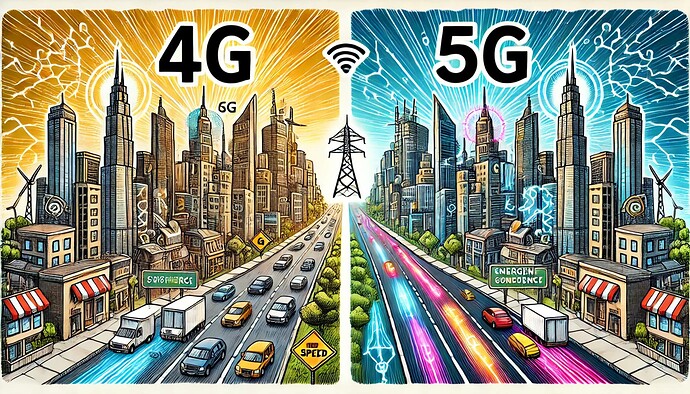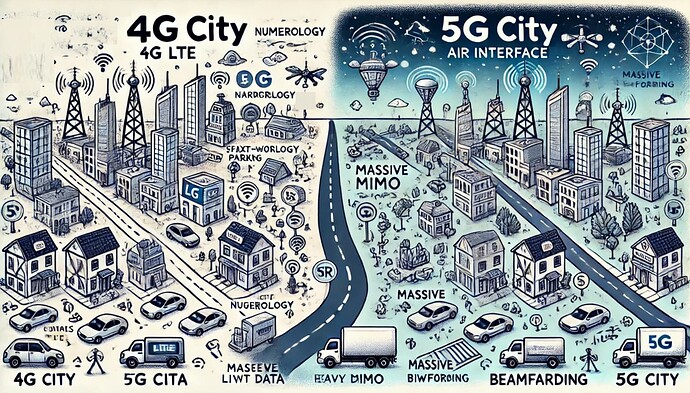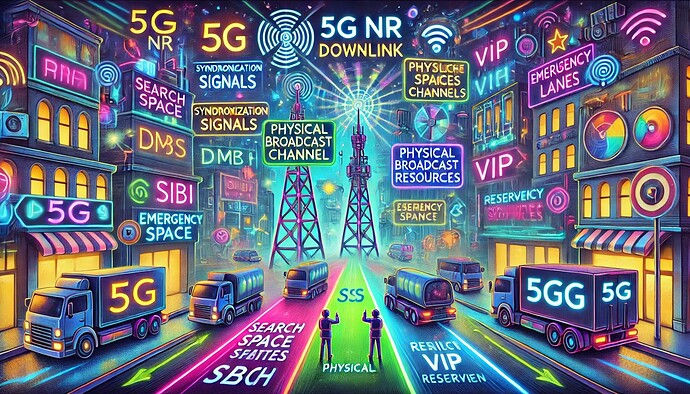This topic presents in a very simplified way all the main concepts that should be understood by those who know 5G NR.
Skip to: Roadmap to 5G NR
- Downlink Transmission Schemes
- Flow of Downlink Data
- System Information
- Uplink Signals and Channels
- Uplink Transmission Schemes
- Beam Management
- UE Measurements
- Measurement Reporting
- Idle Mode Procedures
- Physical and MAC Layer Procedures
- Voice Services
- Signalling Procedures
- Radio Network Planning
- Dynamic Spectrum Sharing
- UE Identities
Fundamentals
5G, the new generation of mobile networks introduced in the 3GPP’s Release 15, is designed to meet three key demands: ultra-fast mobile internet (eMBB), highly reliable, low-latency communications (URLLC), and massive device connectivity (mMTC). While 4G relies on LTE, 5G operates on a network called New Radio (NR), designed to work alongside 4G in a configuration called Non-Standalone (NSA), allowing for a gradual transition. A full 5G setup, or Standalone (SA), connects directly to a new 5G core network, maximizing the speed and efficiency benefits of this new technology. 5G base stations are highly flexible, enabling varied deployments and the use of advanced antennas for enhanced range and capacity. The network uses a broader frequency range to manage congestion and support the high speeds promised by 5G, while also employing advanced technologies like beamforming and MIMO to optimize connections and improve coverage, especially in dense areas. [In a Nutshell: 5G offers faster internet, reliable communication, and connectivity for many devices, using new technology for better performance and coverage.]
![]() *Imagine that 4G is like an old city where people travel on narrow roads and have small buildings. It works fine, but as more people move in, it gets crowded and slow. Now, 5G is like building a brand-new city with wide highways, fast trains, and tall buildings that fit a lot of people. This new city, 5G, has special roads for super-fast cars (for internet), roads for emergency vehicles that need no traffic (for urgent messages), and lots of parking spaces for all the devices people have. At first, people from the old city (4G) can use parts of the new city (5G), but over time, everyone will be able to move fully into the new city and enjoy all its benefits. 5G’s special highways and smart buildings make everything work faster, so nobody has to wait, even if the city gets really busy. [In a Nutshell analogy: 5G is like a modern city with wide, fast roads and plenty of space, designed to keep everything running smoothly as more people use it.]
*Imagine that 4G is like an old city where people travel on narrow roads and have small buildings. It works fine, but as more people move in, it gets crowded and slow. Now, 5G is like building a brand-new city with wide highways, fast trains, and tall buildings that fit a lot of people. This new city, 5G, has special roads for super-fast cars (for internet), roads for emergency vehicles that need no traffic (for urgent messages), and lots of parking spaces for all the devices people have. At first, people from the old city (4G) can use parts of the new city (5G), but over time, everyone will be able to move fully into the new city and enjoy all its benefits. 5G’s special highways and smart buildings make everything work faster, so nobody has to wait, even if the city gets really busy. [In a Nutshell analogy: 5G is like a modern city with wide, fast roads and plenty of space, designed to keep everything running smoothly as more people use it.]
Air Interface
The 5G NR air interface introduces significant advancements over LTE, offering greater flexibility, efficiency, and speed. It introduces numerology, which allows multiple subcarrier spacing options (15 to 240 kHz) for better adaptation to different frequencies and use cases. Bandwidth Parts (BWPs) divide the spectrum into smaller segments, optimizing resource use and power efficiency, while Resource Blocks (RBs) and Physical Resource Blocks (PRBs) dynamically adapt to changing conditions. Wider bandwidths (up to 400 MHz in mmWave) and a more flexible frequency raster enable faster speeds and higher capacity. New features like synchronization raster speed up initial connections, and enhanced waveforms like CP-OFDM and DFT-S-OFDM improve consistency and power efficiency. Additionally, the transmitter and receiver chain (Tx/Rx chain), with technologies like massive MIMO and beamforming, supports higher data rates, wider bandwidths, and complex signal processing. Altogether, 5G NR enables faster, more reliable, and efficient wireless communication tailored to diverse applications and devices. [In a Nutshell: 5G NR air interface improves speed, reliability, and flexibility, using advanced technologies like numerology, BWPs, and massive MIMO.]
![]() Imagine LTE City as a small, simple town with fixed-width roads and parking spots, where cars (data) follow strict schedules and landmarks (signals) are always in the same place, making it predictable but slow when traffic gets heavy. Now, think of 5G City as a futuristic metropolis with roads that can change size to fit small cars or big trucks, smart parking zones that adapt to save space, and ultra-fast highways and bike lanes for efficient traffic flow. Landmarks are spread across the city for quicker navigation, and flying delivery drones (massive MIMO and beamforming) bypass busy roads to deliver packages directly. This futuristic design allows 5G City to handle way more traffic, move things faster, and ensure everyone gets where they need to go smoothly and efficiently. [In a Nutshell: 5G City’s smart, flexible roads and futuristic upgrades handle more traffic and deliver faster, unlike LTE City’s fixed and slower system.]
Imagine LTE City as a small, simple town with fixed-width roads and parking spots, where cars (data) follow strict schedules and landmarks (signals) are always in the same place, making it predictable but slow when traffic gets heavy. Now, think of 5G City as a futuristic metropolis with roads that can change size to fit small cars or big trucks, smart parking zones that adapt to save space, and ultra-fast highways and bike lanes for efficient traffic flow. Landmarks are spread across the city for quicker navigation, and flying delivery drones (massive MIMO and beamforming) bypass busy roads to deliver packages directly. This futuristic design allows 5G City to handle way more traffic, move things faster, and ensure everyone gets where they need to go smoothly and efficiently. [In a Nutshell: 5G City’s smart, flexible roads and futuristic upgrades handle more traffic and deliver faster, unlike LTE City’s fixed and slower system.]
Downlink Signals and Channels
5G NR downlink signals and channels enable efficient communication by organizing and transmitting various types of data from the network to devices. Downlink Channel Mappings ensure that user data, control instructions, and system information are categorized and routed effectively. Key components like Synchronization Signals (SS) and the Physical Broadcast Channel (PBCH) help devices detect the network and establish a connection using combined structures called SS/PBCH Blocks and Bursts. The Physical Downlink Control Channel (PDCCH) sends essential instructions about resource allocation and scheduling, managed within a configurable area called the CORESET (Control Resource Set). Search Space Sets (SSS) help devices locate control signals, including critical information like the System Information Block 1 (SIB1). Data is delivered through the Physical Downlink Shared Channel (PDSCH), optimized with advanced features like Modulation and Coding Scheme (MCS) and dynamic Transport Block Size (TBS) calculations. Supporting these functions are various Reference Signals (RS), such as DMRS (Demodulation Reference Signals) for accurate decoding, and CSI-RS (Channel State Information Reference Signals) for channel quality assessment. Additionally, features like Pre-emption, Reserved Resources, and Repetition ensure reliability and prioritization for critical communications, making 5G far more flexible, efficient, and capable than LTE. [In a Nutshell: 5G organizes, prioritizes, and delivers data more flexibly and efficiently than LTE, ensuring reliability and scalability.]
![]() The city of 5G is a smarter, faster upgrade from the city of LTE, with better organization and advanced traffic systems. In 5G, Synchronization Signals (SS) act as welcome lights, helping devices find their way, while the PBCH (Physical Broadcast Channel) is like a digital map showing city rules, now combined in SS/PBCH Blocks and Bursts for efficiency. PDCCH (Physical Downlink Control Channel) is like traffic officers directing trucks (data) to their destinations, working flexibly in areas called CORESET (Control Resource Set). Devices find instructions in Search Space Sets (SSS), including special help desks like SIB1 Search Space for new visitors. Data is delivered by bigger, faster trucks on the PDSCH (Physical Downlink Shared Channel), optimized by smarter cargo systems like MCS and TBS. To keep things on track, 5G uses advanced markers like DMRS and updates like CSI-RS, while features like Pre-emption and Reserved Resources ensure emergency lanes and VIP routes for critical services. It’s a futuristic city built to handle more traffic and complexity than LTE ever could. [In a Nutshell: 5G is like a futuristic city with smarter traffic systems, ensuring faster and more reliable communication than LTE.]
The city of 5G is a smarter, faster upgrade from the city of LTE, with better organization and advanced traffic systems. In 5G, Synchronization Signals (SS) act as welcome lights, helping devices find their way, while the PBCH (Physical Broadcast Channel) is like a digital map showing city rules, now combined in SS/PBCH Blocks and Bursts for efficiency. PDCCH (Physical Downlink Control Channel) is like traffic officers directing trucks (data) to their destinations, working flexibly in areas called CORESET (Control Resource Set). Devices find instructions in Search Space Sets (SSS), including special help desks like SIB1 Search Space for new visitors. Data is delivered by bigger, faster trucks on the PDSCH (Physical Downlink Shared Channel), optimized by smarter cargo systems like MCS and TBS. To keep things on track, 5G uses advanced markers like DMRS and updates like CSI-RS, while features like Pre-emption and Reserved Resources ensure emergency lanes and VIP routes for critical services. It’s a futuristic city built to handle more traffic and complexity than LTE ever could. [In a Nutshell: 5G is like a futuristic city with smarter traffic systems, ensuring faster and more reliable communication than LTE.]
Downlink Transmission Schemes
![]() read more or skipt to:
read more or skipt to: ![]()
Description (tbd)
![]() Analogy (tbd)
Analogy (tbd)
Flow of Downlink Data
![]() read more or skipt to:
read more or skipt to: ![]()
Description (tbd)
![]() Analogy (tbd)
Analogy (tbd)
System Information
![]() read more or skipt to:
read more or skipt to: ![]()
Description (tbd)
![]() Analogy (tbd)
Analogy (tbd)
Uplink Signals and Channels
![]() read more or skipt to:
read more or skipt to: ![]()
Description (tbd)
![]() Analogy (tbd)
Analogy (tbd)
Uplink Transmission Schemes
![]() read more or skipt to:
read more or skipt to: ![]()
Description (tbd)
![]() Analogy (tbd)
Analogy (tbd)
Beam Management
![]() read more or skipt to:
read more or skipt to: ![]()
Description (tbd)
![]() Analogy (tbd)
Analogy (tbd)
UE Measurements
![]() read more or skipt to:
read more or skipt to: ![]()
Description (tbd)
![]() Analogy (tbd)
Analogy (tbd)
Measurement Reporting
![]() read more or skipt to:
read more or skipt to: ![]()
Description (tbd)
![]() Analogy (tbd)
Analogy (tbd)
Idle Mode Procedures
![]() read more or skipt to:
read more or skipt to: ![]()
Description (tbd)
![]() Analogy (tbd)
Analogy (tbd)
Physical and MAC Layer Procedures
![]() read more or skipt to:
read more or skipt to: ![]()
Description (tbd)
![]() Analogy (tbd)
Analogy (tbd)
Voice Services
![]() read more or skipt to:
read more or skipt to: ![]()
Description (tbd)
![]() Analogy (tbd)
Analogy (tbd)
Signalling Procedures
![]() read more or skipt to:
read more or skipt to: ![]()
Description (tbd)
![]() Analogy (tbd)
Analogy (tbd)
Radio Network Planning
![]() read more or skipt to:
read more or skipt to: ![]()
Description (tbd)
![]() Analogy (tbd)
Analogy (tbd)
Dynamic Spectrum Sharing
![]() read more or skipt to:
read more or skipt to: ![]()
Description (tbd)
![]() Analogy (tbd)
Analogy (tbd)


